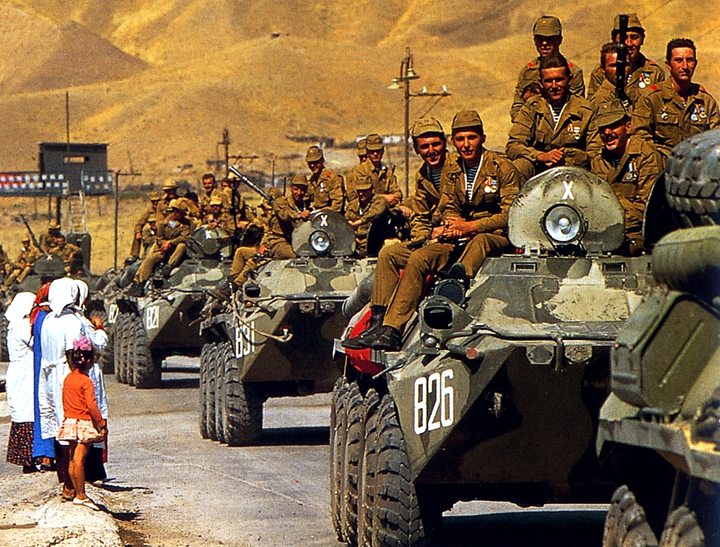February 15 marks the final and complete withdrawal of the Soviet military from Afghanistan, which kicked off 29 years ago and followed the Geneva Accords that were signed to resolve what had become a precarious situation for the USSR throughout the 1980s.
Although the reasons for the Soviet campaign in Afghanistan are still hotly debated in the region, and some facts and figures are suspected of being withheld, one point remains true: The Soviet-Afghan War, which started in 1979, lasted over nine years.
According to some estimates, the USSR sent more than 600,000 of its citizens to serve in Afghanistan between 1979-89, while as many as 15,000 of them were killed and more than 400 went missing.
The war did not bypass Kazakhstan, which was one of the 15 Soviet republics at that time. Located very close to Afghanistan, this Caspian region and Central Asian country sent 22,269 of its citizens into the abyss of war, which killed 924 of them, left 1,000 disabled for life, and another 21 went missing.
Still to this day, many in Kazakhstan recall the events that contributed to the demise of the Soviet Union.
Abdulsattar Asanbek moved to Kazakhstan from Afghanistan six years ago. Now he lives in the city of Kaskelen, located in the country’s Almaty region. For eight years Abdulsattar, who was recruited by the Soviet-backed Democratic Republic of Afghanistan, fought against the mujahideen that waged jihad, or holy war, against the invading Soviet forces.
“At that time, the Afghan government was recruiting soldiers into the army not so strictly. It was enough that a recruit had hands and feet and was 18 years old,” Asanbek recalls, according to Radio Free Europe.
“We were taken to Termez (a city in Uzbekistan), where we joined the training courses for tank operators. We continued our studies in Kabul, we studied for nine months. Then we were let out on the battlefield.”
Termez was where the last Soviet military battalion said goodbye to Afghanistan, after crossing a bridge over the Amu Darya River, dubbed “Friendship Bridge.”
Not all of the soldiers that fought went voluntarily.
Kazakhstan-born Uali Akhmet joined the government troops by accident. After Soviet troops entered Afghanistan, his parents left for Iran, frightened from a possible war.
“When I was 18 years old, my friend, Barakat, and I [acquired] documents to go to Turkey. However, our documents proved to be counterfeit. We were detained at the Iranian-Turkish border, taken to the Iranian-Afghan border, and released in Afghanistan. For about three years, we fought alongside the Russian troops,” Akhmet says.
Some may say that war is not a place for women, but the Karaganda-born Ryskul Mukhamedkarimova and Karlygash Umirzakova can be considered an exception.
These two women have become friends, and do not like talking about the horrors they witnessed. But they recall the chloride-ridden water that made their teeth black, drugs that were sold openly on the streets, and shops that were once bursting with Western goods.
“Afghanistan gave me a lot, it taught [me] to understand people, helped to remove rose-colored glasses,” Ryskul says. “I felt sorry for the guys. Today you are sitting with them at the table, singing songs to the guitar, and the next day they are killed.”
After the war ended, Kazakhstan joined the peacekeeping contingent stationed on the Tajik-Afghan border.
On November 30, 1992, top officials from Russia, Kazakhstan, Uzbekistan, and Kyrgyzstan met in Termez, where they agreed to send their peacekeepers to Tajikistan to guard the border from bandits, drug dealers and arms smugglers. With a length of 1,344 kilometers (835 miles), this section of the border is considered one of the most vulnerable areas in Central Asia.







 Russian peacekeeping forces, deployed in the Karabakh (Garabagh) region of Azerbaijan since 2020, have commenced their withdrawal from the area.
Russian peacekeeping forces, deployed in the Karabakh (Garabagh) region of Azerbaijan since 2020, have commenced their withdrawal from the area.
 Iran's senior military leaders described the drone and missile attack on Israel on April 14 night as “successful".
Iran's senior military leaders described the drone and missile attack on Israel on April 14 night as “successful".
 Azerbaijan officially unveiled the logo for the upcoming 29th session of the Conference of the Parties to the United Nations Framework Convention o...
Azerbaijan officially unveiled the logo for the upcoming 29th session of the Conference of the Parties to the United Nations Framework Convention o...
 Iranian President Ebrahim Raisi warned Israel that it would face a "real and extensive" response if it makes any "mistake" following Tehran’s missi...
Iranian President Ebrahim Raisi warned Israel that it would face a "real and extensive" response if it makes any "mistake" following Tehran’s missi...



